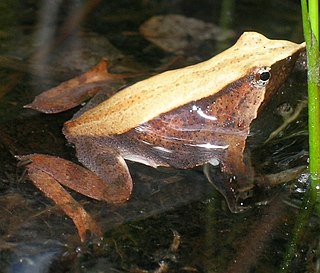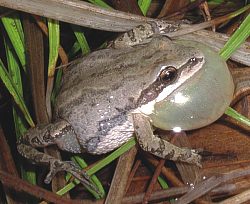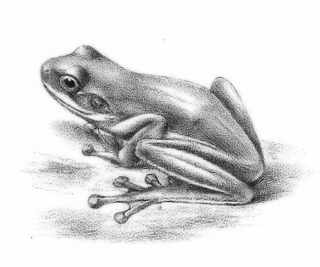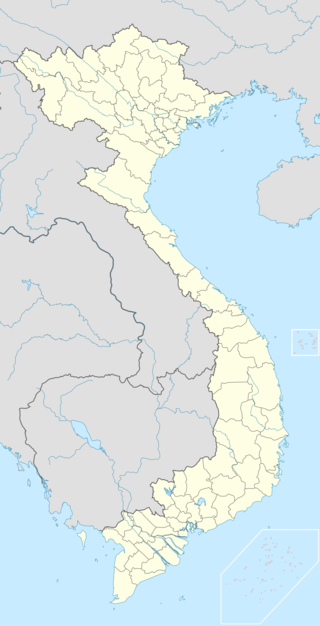
Lithobates pipiens or Rana pipiens, commonly known as the northern leopard frog, is a species of leopard frog from the true frog family, native to parts of Canada and the United States. It is the state amphibian of Minnesota and Vermont.

Darwin’s frog, also called the Southern Darwin's frog, is a species of Chilean/Argentinian frog of the family Rhinodermatidae. It was discovered by Charles Darwin during his voyage on voyage on HMS Beagle. on a trip to Chile. In 1841, French zoologist André Marie Constant Duméril and his assistant Gabriel Bibron described and named Darwin's frog. The diet of R. darwinii consists mostly of herbivore invertebrates. R. darwinii is currently classified as an endangered species by the International Union for Conservation of Nature.

Agalychnis callidryas, commonly known as the red-eyed tree frog, is a species of frog in the subfamily Phyllomedusinae. It is native to forests from Central America to north-western South America. This species is known for its bright coloration, namely its vibrant green body with blue and yellow stripes on the side. It has a white underside, brightly red and orange colored feet, and is named after its distinctive bright red eyes.

The golden coquí is a rare species of frog endemic to Puerto Rico.

The mountain yellow-legged frog, also known as the southern mountain yellow-legged frog, is a species of true frog endemic to California in the United States. It occurs in the San Jacinto Mountains, San Bernardino Mountains, and San Gabriel Mountains in Southern California and the Southern Sierra Nevada. It is a federally listed endangered species.

The strawberry poison frog, strawberry poison-dart frog or blue jeans poison frog is a species of small poison dart frog found in Central America. It is common throughout its range, which extends from eastern central Nicaragua through Costa Rica and northwestern Panama. The species is often found in humid lowlands and premontane forest, but large populations are also found in disturbed areas such as plantations. The strawberry poison frog is perhaps most famous for its widespread variation in coloration, comprising approximately 15–30 color morphs, most of which are presumed to be true-breeding. O. pumilio, while not the most poisonous of the dendrobatids, is the most toxic member of its genus.

The gastric-brooding frogs or platypus frogs (Rheobatrachus) is a genus of extinct ground-dwelling frogs native to Queensland in eastern Australia. The genus consisted of only two species, both of which became extinct in the mid-1980s. The genus is unique because it contains the only two known frog species that incubated the prejuvenile stages of their offspring in the stomach of the mother.

The squirrel tree frog is a small species of tree frog found in the south-eastern United States, from Texas to Virginia. This is an introduced species in the Bahamas. Squirrel tree frogs are small frogs, about 1.5 inches in length as adults. There are several color variations, but most commonly they are green and look very much like the American green tree frog. They can also be varying shades of yellow or brown, sometimes with white or brown blotching.

The western chorus frog, also known as striped chorus frog, or midland chorus frog is a species of frog found in Canada and the United States.

The golden poison frog, also known as the golden dart frog or golden poison arrow frog, is a poison dart frog endemic to the rainforests of Colombia. The golden poison frog has become endangered due to habitat destruction within its naturally limited range. Despite its small size, this frog is likely the most poisonous animal on the planet.

The granular poison frog or granular poison arrow frog is a species of frog in the family Dendrobatidae, found in Costa Rica and Panama. Originally described as Dendrobates granuliferus, it was moved to Oophaga in 1994. Its natural habitats are tropical humid lowland forests; it is threatened by habitat loss.
The bromeliad tree frog is a species of frogs in the family Hylidae.

The Costa Rica brook frog or red-eyed stream frog is a species of frog in the family Hylidae found in Costa Rica and Panama. Its natural habitats are tropical moist lowland forests, subtropical or tropical moist montane forests, and rivers between 70 and 1740 meters above sea level.

Phytotriades is a genus of tree frogs in the family Hylidae. As currently delimited, the genus is monotypic and contains Phytotriades auratus, commonly known as the golden tree frog, bromeliad-dwelling treefrog, El Tucuche golden tree frog, or Trinidad heart-tongued frog.
Sarcohyla cembra, also known as the Southern Sierra Madre treefrog, is a species of frog in the family Hylidae. It is endemic to Mexico. Until recently, it was only known from two male specimens: one from its type locality on the Pacific slopes of the Sierra Madre del Sur mountains, Pochutla District, Oaxaca, and another one from Sierra de Yucuyacua south-east of Llano de Guadalupe, in north-west Oaxaca. The two locations are about 172 km (107 mi) apart. After having not been seen after 1993, it was feared that the species might be extinct. However, the species was rediscovered in field surveys in 2011–2012, extending its range with a new locality about 10 km north of the type locality.
Craugastor andi is a species of rain frog in the family Craugastoridae which has not been seen since 1990. It is found in the Caribbean drainage of Costa Rica in the mountains and hills of the Cordillera Central and the far northeastern Cordillera de Talamanca, and in extreme northwestern Panama. Frank and Ramus (1995) give it the vernacular name Atlantic robber frog. It is known locally in Spanish by the generic names, used for many species, of rana de hojarasca, ranita or sapito.

Rhacophorusvampyrus(Vampyrius Vampyrus) is a medium-sized species of flying frogs endemic to Vietnam. It is found in Southern Vietnam, and is not known to be found in other places globally. It Is in the kingdom Animalia, phylum Chordata, and class Amphibia. Along with this, it is in the order Anura, family Rhacophoridae, and it is the only member of the genus Vampyrus. It is also known as the vampire tree frog or the vampire flying frog because of the presence of a pair of fang-like hooks in mouth of the tadpoles. Its Vietnamese name is Ếch cây ma cà rồng.

Rhacophorus kio is a species of flying frog in the family Rhacophoridae and is found in the rainforests of southeast Asia, in countries such as China, Laos, Thailand, and Vietnam. Its ability to glide and its adhesive toe pads make it well adapted to its habitat of the rainforest. Before a 2006 study by Annemarie Ohler and Magali Delorme, R. kio and Rhacophorus reinwardtii were thought to be the same species. The common name black-webbed treefrog can refer to either species. Compared to other frog species in the area, R. kio not only creates a foam nest that holds their eggs, but also creates a structure with leaves that will wrap around the eggs. While the conservation status of the species is currently classified as of least concern by the IUCN Red List, R. kio faces habitat loss from deforestation to make space for agriculture and other human influences.
Bromeliohyla melacaena is a frog in the family Hylidae endemic to Honduras. Scientists have observed it in pine forests between 1370 and 1990 meters above sea level.















